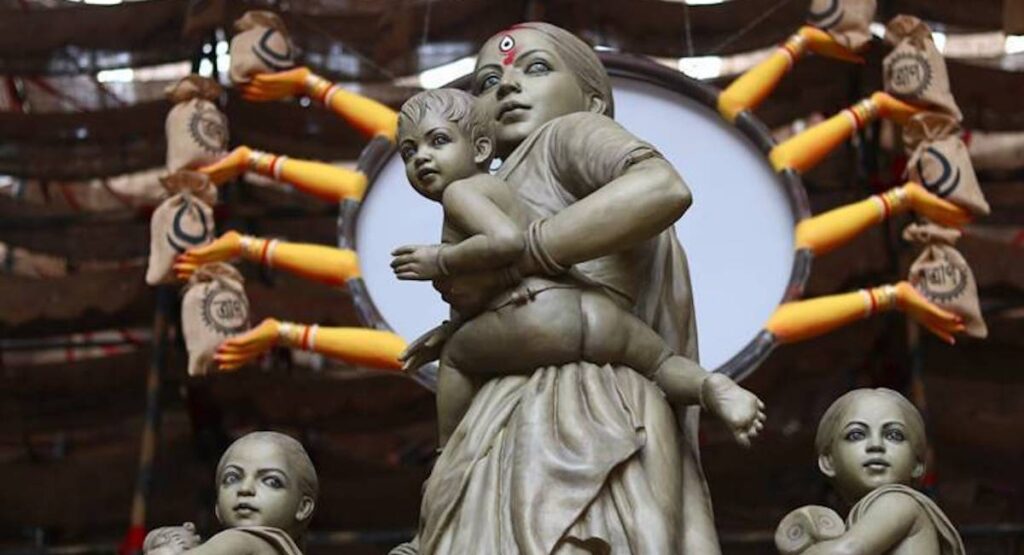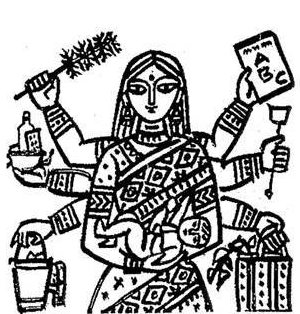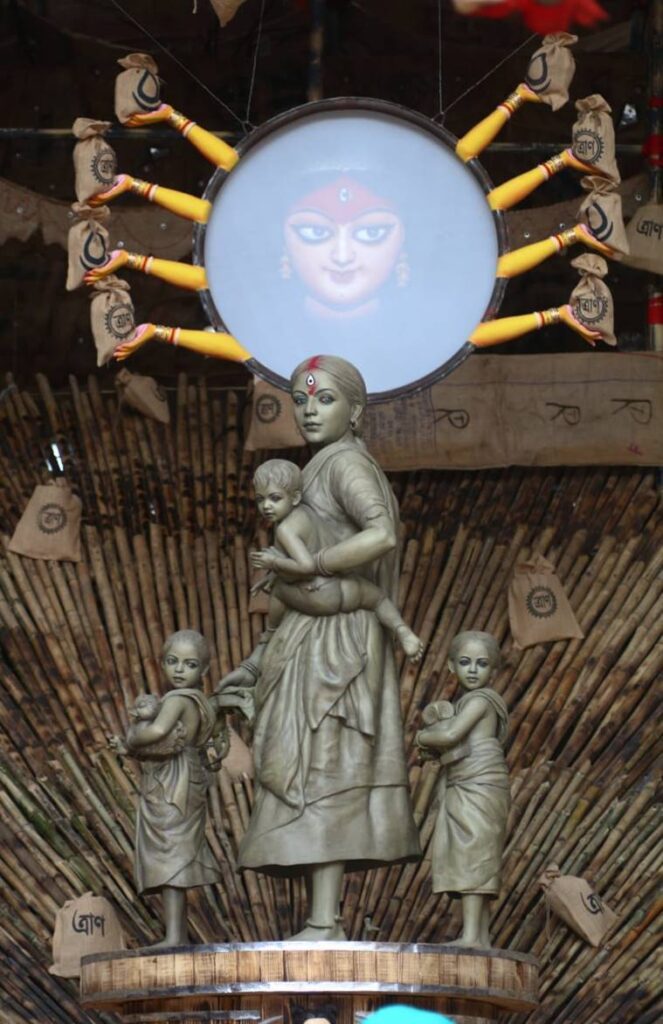
This reflection was originally given by Anu Yadav during the Freedom Church of the Poor on Sunday, Nov. 15, 2020. Watch the video of the service here.
This past weekend hundreds of millions of Hindus celebrated Diwali, the festival of lights, a significant holiday marking the new year and the triumph of good over evil, of knowledge over ignorance. During Diwali, many pray to Lakshmi the Goddess of Abundance and Prosperity. In some traditions she is a manifestation of Durga, the warrior goddess.
Before he passed, my Nanaji, my grandfather, gave me a necklace with Durga’s image and spoke of a temple deep in the forest you can only get to by foot. One day, he said, I should go. The more I learn about her, the more I realize how much our Freedom Church of the Poor is also her temple, her mandir. Garibon ke aazaadi ka mandir. When we pray with our feet, when we take action together as a movement of the poor and dispossessed we worship her. In my own journey, I am learning how Hinduism is many distinct indigenous spiritual traditions that over thousands of years have been shaped by many contending social forces. One reason Gods and Goddesses have so many names is that it depends what land your people are from, in practices that predate what we call Hinduism today.

Within the Shaktism traditions of Hinduism, female deities are not just consorts to male gods, they are independently powerful, with agency in their own right. The Chandi Path or Devi Mahatmyam is a key text that tells a story of Durga’s battle against the empire of a King, who became so powerful he was going to destroy the earth and everything in it. The Gods, reduced to living in caves, feared his might. They knew they could not defeat him alone so they called upon the Divine Mother to join their powers and manifest Durga Ma, the essence of them combined. She who is before and after. Her multiple arms signify the powers of each God in one body.
This King sends messengers to her, demanding she be his Queen. She replies demurely, “I apologize for my rudeness but I invite you to come and fight me.” He becomes so enraged he rains armies of demons upon her and, to his shock, she slays them all. But as their blood soaks into the earth, thousands more spring to life. Kali, a Goddess of War, emerges from Durga’s brow to drink up their blood before it spills to the ground as Durga slays all the demon armies and eventually the king himself.

There are many interpretations of this story. One is that it represents the fight we wage today. Durga symbolizes the movement of the poor and dispossessed who collectively hold the creativity, the understanding and the leadership to move as one body with many arms to vanquish not an individual, but the brutal systemic oppressions that rain upon us and will cause 410,000 estimated deaths in the U.S. from COVID by the end of this year — the triple crises of climate, an economic recession rivaling the Great Depression, and the pandemic, the evictions, the hunger. Durga and Lakshmi represent our charge to care for all life and all sources of life, for Mother Nature. They represent the unpaid labor of poor women and the critical importance of women’s leadership in our movement. You can see this connection being made today in the temple that replaced their statues of goddesses with that of female migrant workers, displaced and unemployed due to COVID.
The many arms of our movement body include Put People First! PA fighting the closure of hospitals in a pandemic, the Apache Stronghold fighting the destruction of their sacred land, Chaplains on the Harbor in Washington State fighting the ongoing assault on the poor, and many more who make up the Poor People’s Campaign: A National Call for Moral Revival.
“As we celebrate Diwali we must continue to pray with our feet, lighting the lamp of truth and justice as one body waging an epic battle against the systems that cause our suffering for a new one that must be born.”
As we celebrate Diwali we must continue to pray with our feet, lighting the lamp of truth and justice as one body waging an epic battle against the systems that cause our suffering for a new one that must be born. As one body we are Durga, which means an unassailable fortress, forging our path to moksha, liberation — not an individual battle of the ego but a collective struggle because we only attain liberation together. In doing so we shall witness our inevitable victory of abundance for not just the few but for us all.
I’ll end with the words of the great Pakistani revolutionary poet Faiz Ahmed Faiz, from his poem, “Hum Dekhenge,” “We Shall See,” which became, in its own right, an anthem of protest against injustice.
ہم دیکھیں گے ۔ فیض احمد فیض
ہم دیکھیں گے
لازم ہے کہ ہم بھی دیکھیں گے
وہ دن کے جس کا وعدہ ہے
جو لوحِ ازل پہ لکھا ہے
ہم دیکھیں گے
جب ظلم و ستم کے کوہِ گراں
روئی کی طرح اُ ڑ جائیں گے
ہم محکوموں کے پاوٗں تلے
یہ دھرتی دھڑ دھڑ دھڑکے گی
اور اہلِ حکم کے سر اوُپر
جب بجلی کڑ کڑ کڑکے گی
ہم دیکھیں گے
جب ارضِ خدا کے کعبہ سے
سب بت اُٹھوائے جائیں گے
ہم اہلِ صفا مردودِ حرم
مسند پر بٹھلائے جائیں گے
سب تاج اُچھالے جائیں گے
سب تخت گرائے جائیں گے
بس نام رہے گا اللہ کا
جو غائب بھی ہے حاضر بھی
جو منظر بھی ہے ناظر بھی
اُٹھے گا انالحق کا نعرہ
جو میں بھی ہوں اور تم بھی ہو
اور راج کرے گی خلقِ خدا
جو میں بھی ہوں اور تم بھی ہو
ہم دیکھیں گے
لازم ہے کہ ہم بھی دیکھیں گے
ہم دیکھیں گے
We shall see
Certainly we, too, shall see
that day that has been promised to us
When these high mountains
Of tyranny and oppression
turn to fluff and evaporate
And we oppressed
Beneath our feet will have
this earth shiver, shake and beat
And heads of rulers will be struck
With crackling lightening
and thunder roars.
When from this God’s earth’s (Kaa’ba)
All falseness will be removed
Then we of clean hearts-condemned by Zealots those keepers of
Faith,
We, will be invited to that altar to sit and Govern-
When crowns will be thrown off- and over turned will be thrones
We shall see
Certainly we, too, shall see
that day that has been promised to us
The God’s name will remain (Allah will remain)
Who is invisible and visible too
Who is the seer and is seen
There will rise one cheer- I am God!
Who I am too
and so are you
Then the masses, people of God will rule
Who I am too
and so are you
There will rise one cheer- I am God!
Who I am too
and so are you
(Urdu version here; English translation from Anti-Serious.)